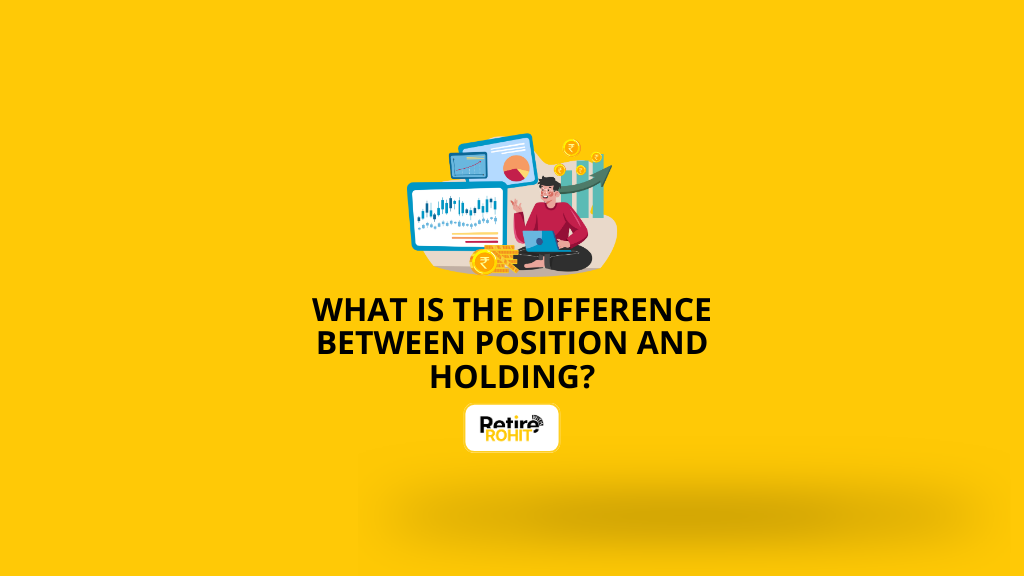What is the Difference Between Position and Holding?

If you've ever used apps like Zerodha, Upstox, or Groww, you’ve probably seen two words that look very similar but actually mean different things: Position and Holding. And yes, they confuse the hell out of most people. Here, we will clarify the difference between these two terms: Position and Holding.
What is Position?
A position means you’ve bought or sold shares today, and you plan to finish the deal on the same day. You’re not investing. You’re trading. It’s mostly used in intraday trades or F&O (Futures & Options).
Imagine you invite a guest to your house, they come in the morning and leave by evening. They don’t stay overnight. That’s exactly what a position in the stock market is.
- Long Position: Where you buy a stock expecting its price to rise.
- Short Position: Where you sell a stock that you don’t own, expecting to buy it back at a lower price.
For Example:
Let’s say, Sahil opened the Groww app and bought 100 shares of Tata Motors at ₹700 per share at 9:30 AM. Sell them at ₹710 per share at 1:00 PM. You earned a profit of ₹10 per share.
That’s a position; you opened and closed the trade on the same day.
Key Points of a Position
Here are some key points:
- Type: Mostly used in Intraday trading or F&O (Futures & Options)
- Duration: Same-day trade only, you must buy and sell before the market closes.
- Do You Own the Shares: Nope, shares are shown temporarily in your account, but not delivered to the demat account.
- Risk Level: High, prices move quickly, and you can lose money in minutes.
- Margin Available: Yes, brokers like Zerodha, Upstox, etc., give extra buying power (leverage).
What is Holding?
A holding is when you buy shares and keep them in your demat account for more than a day. These shares are fully yours; you actually own them. You're not just trading for quick profit. You're investing.
Imagine you go to Big Bazaar or DMart and buy a bunch of groceries. You don’t eat all of them today; you store them in your kitchen. That’s exactly how a holding works in the stock market.
For Example:
Let's say on Monday, Raj bought 10 shares of Infosys at ₹1,500 each. You don’t sell them that day. You hold onto them. Maybe for a week, a month, or even 10 years.
These shares now become your holdings. They get delivered to your demat account, and you can check them anytime under the "Holdings" section in apps like Zerodha or Groww.
Key Points of a Holding
Here are some key points:
- Type: This is delivery-based trading, you buy shares and they’re delivered to your demat account.
- Duration: You hold the shares for more than one day, which could be weeks, months, or even years.
- Ownership of Shares: Yes, these shares are fully yours. You can sell them anytime.
- Risk Level: Generally lower than intraday, since it’s based on long-term growth and not quick price movements.
- Margin Available: No, you need to pay the full amount to buy. No extra leverage from the broker.
Key Difference Between Position and Holding
Here are the differences between Position and Holding:
| Feature | Position | Holding |
| Definition | It means tallying the investor stake in a particular asset or financial security. | It's a tally of all the securities that you currently own in your investment portfolio. |
| Time Frame | This is generally short-term. | This can be short-term or long-term. |
| Purpose | To capitalise on market movements | To ensure long-term wealth building and portfolio diversification. |
| Includes Short Sell | Yes, this included both long positions and short positions. | No, they only represent what you own, as short selling doesn’t create a holding. |
| Example | Holding a long-term/short-term position in Apple Inc. | Holding 200 shares of Apple in your portfolio. |
Also, check - ETFs vs Mutual Funds: Understanding the Key Differences
Conclusion
In conclusion, if you’re just starting out and confused, stick to holding, not position.
- Treat intraday like fast bowling = thrilling but risky.
- Holding is like test cricket = slow, strategic, and often rewarding.
Whether you are trading or building a long-term investment portfolio. You need to know the difference between these terms because this will help you navigate the financial markets. So we hope our blog on the difference between position and holding is helpful.


